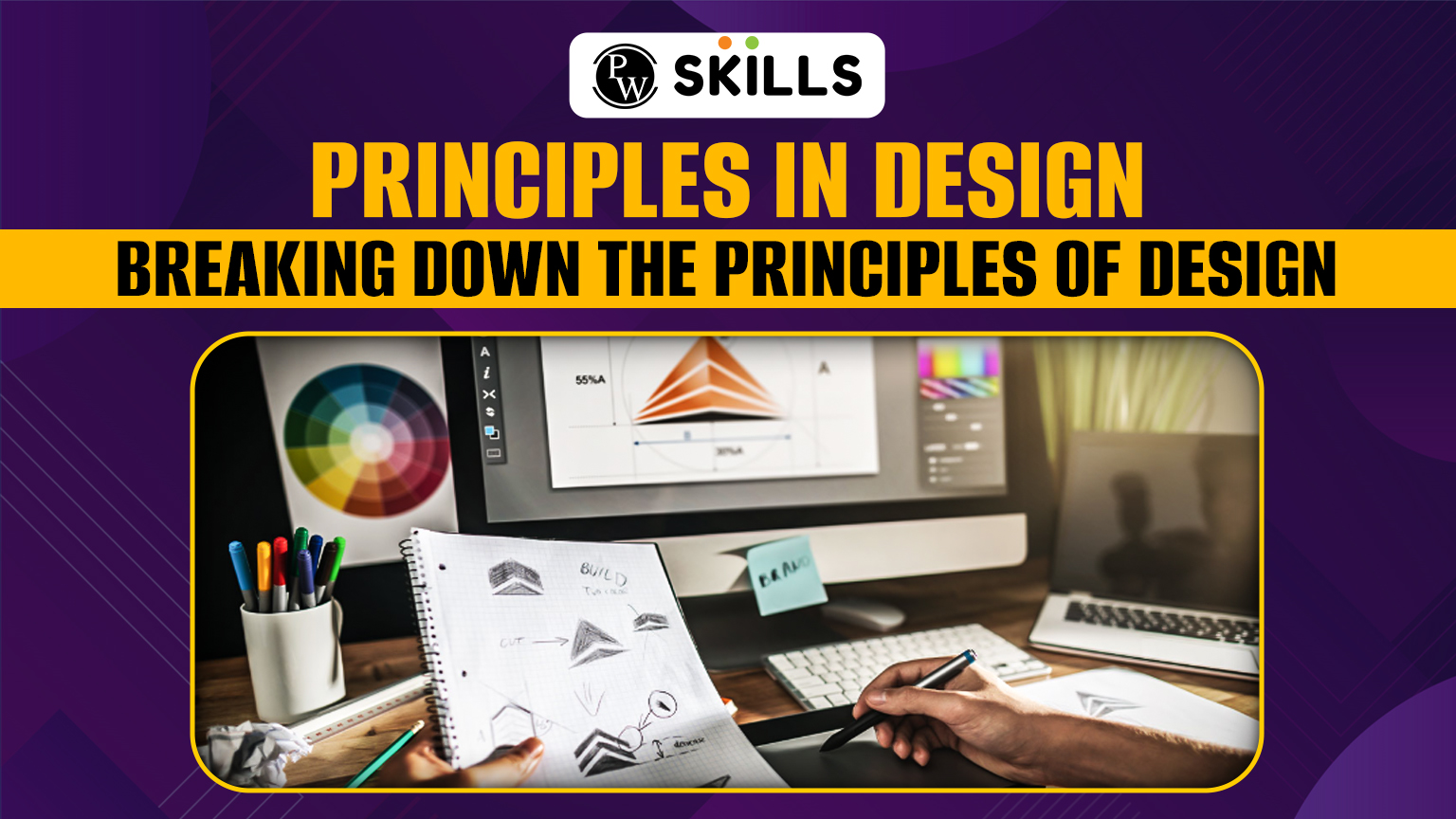Principles In Design: Have you ever wondered how designers create visually appealing and effective designs? The answer lies in understanding the principles in design. While there’s debate about the exact number of desidesign principles, twelve key ones frequently emerge in discussions. These include contrast, balance, emphasis, proportion, hierarchy, repetition, rhythm, pattern, white space, movement, variety & unity.
Each principle serves a unique purpose, yet they all work together to craft designs that are both engaging and functional. For instance, contrast helps different elements stand out, while balance ensures that the design feels harmonious. Expert designers combine these ideas to get the intended visual and functional impact. In this article, you’ll delve into these principles in design and see examples of how they apply to graphic design and patterns.
Why Is Understanding the Principles of Design Important?
Learning about the principles in design is crucial because they help improve the quality and functionality of your designs. By learning these principles, you can solve design problems more effectively.
“For example, designers like Steve Jobs used principles such as simplicity and balance to create visually appealing and user-friendly products.”
Applying the principles of graphic design and principles of design patterns allows you to create more cohesive and professional work. Whether you’re working on an advertisement or a website, mastering these principles will help you achieve high-quality designs that stand out.
Also Read: What is UI and UX Training?
Top 12 Principles In Design
The principles in design are essential guidelines that help create visually appealing and effective designs. While there is some debate about the exact number, twelve key principles are widely recognized by designers and mentioned in most resources.

These principles of design pattern ensure a balanced, cohesive, and user-friendly result when applied properly. Below are the top 12 principles in design that every designer should know.
1. Contrast
Contrast is a key principle in design that highlights the differences between elements, like light versus dark or big versus small, to make certain parts stand out. It’s crucial for creating visually engaging designs and ensuring readability, especially for those with visual impairments.

Effective contrast can be achieved through various methods:
- Colour: Using light colours against dark backgrounds.
- Size: Making one element significantly larger than another.
- Shape: Pairing a sharp-edged element with a rounded one.
- Texture: Contrasting smooth surfaces with rough textures.
When used wisely, contrast enhances the design’s appeal and focus. However, overuse can make the design feel chaotic, so it’s important to apply it strategically. This principle of graphic design helps guide attention and create visually balanced designs.
2. Balance
Balance is a crucial principle in design that ensures visual elements are evenly distributed to create a stable and appealing layout. There are two main types of balance: symmetrical and asymmetrical. Symmetrical balance involves arranging similar elements equally on either side of a central axis, while asymmetrical balance uses different elements that still create a balanced look.
To use balance effectively:
- Symmetrical: Place identical or similar elements on both sides for a uniform look.
- Asymmetrical: Use varying elements, such as a large dark shape balanced by a smaller light one, to create interest and dynamism.
Balance helps ensure that no part of the design feels too heavy or too light, making the overall design easier to understand and visually pleasing.
3. Emphasis
Emphasis is one of the key principles in design that highlights the most important parts of a design, making them stand out. It ensures that the viewer notices the main message or element. For example, a large, bold headline draws attention, while smaller text in a less noticeable colour is used for additional details.
To use emphasis effectively:
- Color: Use bright or contrasting colors for key elements.
- Size: Make important items larger to catch the eye.
- Placement: Position critical elements prominently.
Emphasis directs focus and ensures that crucial information is easily noticed while less important details are less prominent.
4. Proportion
Proportion is a straightforward principle in design that refers to the size of elements in relation to each other. It helps to show what’s important by making certain elements larger or smaller. For instance, in a website layout, a large header might indicate its importance compared to the smaller text below.
To use proportion effectively:
- Size: Make key elements larger to highlight their importance.
- Scale: Ensure that all elements fit well together, like having a main image that is balanced with the surrounding text.
Good proportion ensures that elements are visually harmonious and emphasizes the most crucial parts of the design.
5. Hierarchy
Hierarchy is an important principle in design that organizes elements by their importance, making it easier for users to process information. It ensures that the most crucial elements stand out. For example, a bold, large headline will draw attention first, followed by smaller subheadings and body text.
To use hierarchy effectively:
- Size: Use larger fonts for titles and smaller fonts for supporting text.
- Colour: Highlight key elements with contrasting colours.
- Placement: Position important items at the top or centre.
Effective hierarchy helps guide the viewer’s focus, making the design clearer and more intuitive.
6. Repetition
Repetition is a key principle in design used to create consistency and reinforce ideas by repeating elements like colours, fonts, or shapes. For example, using the same colour scheme or typeface throughout a website helps unify the design and make it cohesive.

To use repetition effectively:
- Consistency: Apply the same fonts and colours across different parts of the design.
- Patterns: Incorporate regular patterns to strengthen the visual appeal.
- Variety: Add slight variations to keep the design interesting and engaging.
Repetition helps make designs more recognizable and cohesive, improving overall visual harmony.
7. Rhythm
Rhythm is an essential principle in design that creates a sense of movement and pattern, much like rhythm in music. It involves repeating elements at regular intervals to guide the viewer’s eye. There are five main types of visual rhythm: random, regular, alternating, flowing, and progressive.
To use rhythm effectively:
- Regular Rhythm: Use consistent spacing between elements for a predictable pattern.
- Alternating Rhythm: Create a repeating pattern with variations, like alternating colours or shapes.
- Flowing Rhythm: Follow natural curves or shapes to guide the eye smoothly.
- Progressive Rhythm: Gradually change elements to show movement over time.
Rhythm helps create visual interest and guides how viewers perceive and interact with a design.
8. Pattern
Patterns in design refer to the repetition of design elements to create a cohesive look. For example, a classic wallpaper design uses repeating shapes or colours to form a pattern. In web design, patterns can also mean standard layouts or elements that users commonly encounter, like a navigation bar at the top of a page.

To use patterns effectively:
- Consistency: Apply repeating elements like colours or shapes to create a unified design.
- Standards: Use familiar design patterns, such as top navigation menus, to make interfaces intuitive.
Patterns help maintain visual harmony and ensure users can easily navigate and understand the design.
9. White Space
White space, or negative space, refers to the empty areas in a design that don’t contain any elements. It’s crucial because it gives other design elements room to breathe and makes them stand out more. For example, a simple layout with plenty of white space around a call-to-action button can make it more noticeable and engaging.
To use white space effectively:
- Legibility: Ensure text is easy to read by leaving space around it.
- Focus: Highlight important elements by surrounding them with empty space.
- Branding: Use white space creatively to add hidden elements or messages.
White space helps create a balanced, clean design and improves overall user experience.
10. Movement
Movement is a key principle in design that guides how the viewer’s eye travels across a design. It helps direct attention from one element to the next, using positioning, emphasis, and design elements. For example, a well-placed arrow or line can lead the viewer’s eye towards a call-to-action button.
To use movement effectively:
- Lines: Use lines to guide the viewer’s gaze in a specific direction.
- Shapes: Arrange shapes to create a visual path.
- Colors: Apply color contrasts to draw attention to key areas.
Movement helps create a visual flow and ensures important elements are noticed and understood.
11. Variety
Variety is an important principle in design that adds visual interest and prevents monotony. By incorporating different colours, shapes, fonts, and images, variety keeps the design engaging. For example, a website might use varied font sizes and colours to highlight different sections and maintain user interest.

To use variety effectively:
- Colours: Mix different hues to create visual contrast.
- Typography: Combine various fonts to emphasize key information.
- Shapes: Use diverse shapes to break up uniformity.
Variety should enhance, not overwhelm, the design, helping to create a more dynamic and enjoyable user experience.
12. Unity
Unity is a key principle in design that ensures all elements work together harmoniously. It involves creating clear relationships between visual elements so that the design feels cohesive and organized. For example, a well-designed brochure uses consistent colours, fonts, and layouts to make all sections feel connected.
To use unity effectively:
- Consistency: Apply the same design patterns across different elements.
- Alignment: Ensure elements are properly aligned to create a structured look.
- Repetition: Use repeating elements to reinforce the design’s overall theme.
Unity makes a design look polished and ensures that all parts contribute to a clear, unified message.
Also Check: 10 Best Courses For UI UX Design That Will Make You a Pro
Mastering these principles in design is crucial for creating visually compelling and effective designs. By applying principles like contrast, balance, and unity, designers can ensure their work is not only attractive but also clear and impactful. These principles help guide the viewer’s eye and enhance the overall effectiveness of any design project.
Learn UI/UX Design With PW Skills
Enhance your career prospects with PW Skills’ comprehensive UI/UX Design course. Our program equips you with essential design principles and methodologies to create effective software designs.
From industry-oriented curriculum to practical projects, you’ll gain valuable skills and insights. Our course offers job assistance and industry mentorship to help you build a strong portfolio and secure interviews with top IT firms.
Here are some of the Course Highlights:
- Diverse Project Portfolio: Develop a dynamic portfolio with real-world projects.
- Industry Mentorship: Get guidance from experts in the field.
- Interview Opportunities: Access job interviews with leading companies.
- Certification: Earn recognized certificates for course completion.
- Career Growth: Opportunities to advance and fast-track your career.
Ready to elevate your design skills? Join now for the PW Skills UI/UX Design Online Course and start creating standout designs today!
Principles of Design FAQs
Q1. What are the principles of design?
Ans. The principles of design include contrast, balance, emphasis, proportion, hierarchy, repetition, rhythm, pattern, white space, movement, variety, and unity. They help create visually appealing and functional designs by guiding how design elements interact.
Q2. What is the purpose of the principles of design?
Ans. The principles of design shape how users perceive and interact with a design. When used effectively, they enhance the user experience and create a meaningful emotional impact, making designs more engaging and functional.
Q3. How do the principles of design work together?
Ans. The principles of design, like balance, contrast, and unity, guide how elements are arranged in a design. They work together to create visual interest and ensure that the design is both aesthetically pleasing and effective.
Q4. What are the elements of design and principles of design?
Ans. Elements of design include line, shape, colour, and texture, which are the basic building blocks of any design. Principles of design, such as balance and contrast, describe how these elements should be used together for optimal results.
Q5. How can I apply the principles of design in my projects?
Ans. To apply the principles of design, start by understanding each principle and how it affects the overall look and feel of your project. Use contrast to highlight key elements, balance to distribute visual weight, and unity to ensure all elements work together harmoniously.

